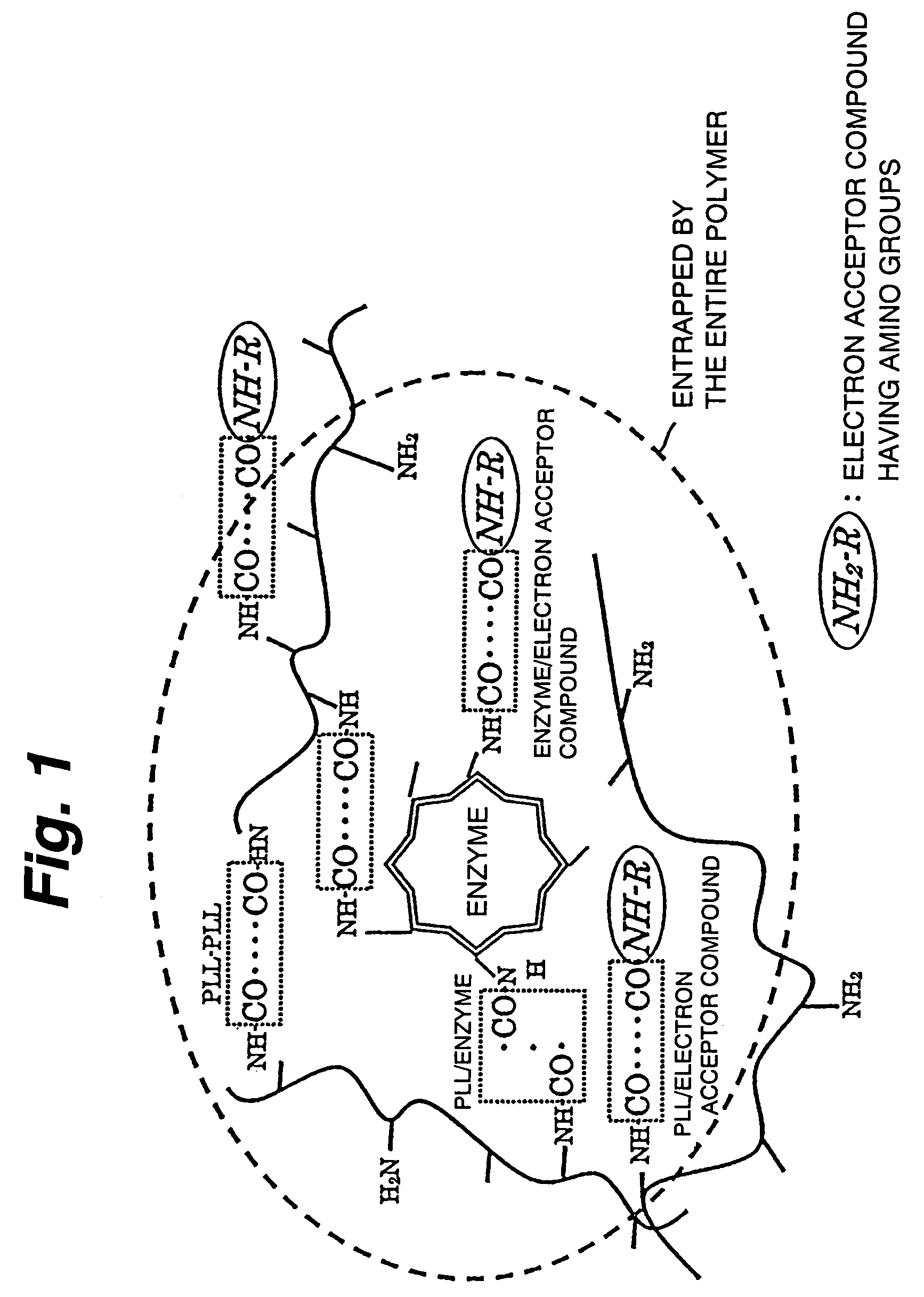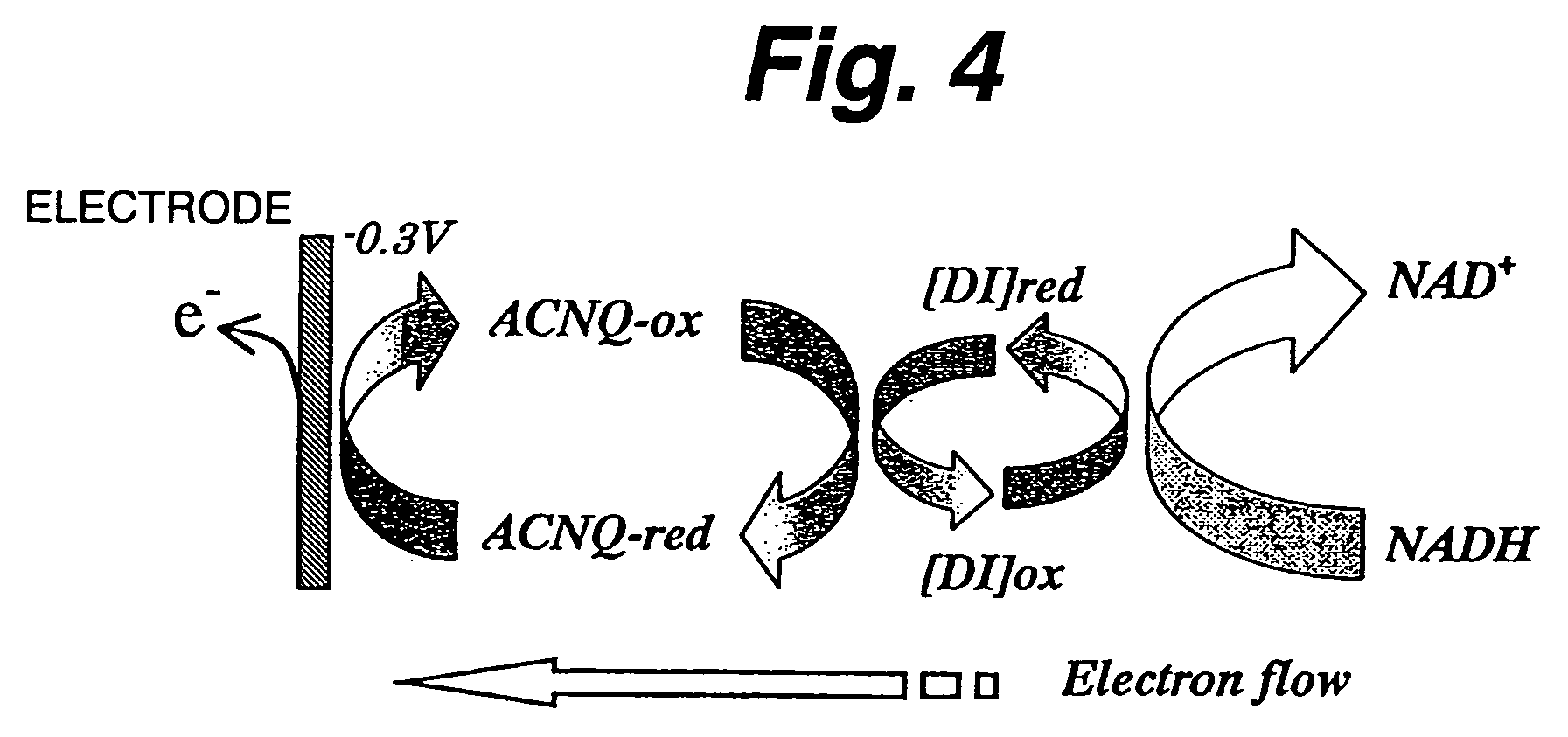Immobilization support, process for producing the same, electrode, process for producing the same, electrode reaction utilizing apparatus and process for producing the same
a technology of immobilization support and electrode, which is applied in the direction of immobilised enzymes, diaphragms, fuel cells, etc., can solve the problems of uneconomical use, extreme technical difficulty in recovering and re-using enzymes out of the solution after reaction, and method cannot be a general technique for immobilization, so as to facilitate the transfer of electrons between enzymes and electrodes
- Summary
- Abstract
- Description
- Claims
- Application Information
AI Technical Summary
Benefits of technology
Problems solved by technology
Method used
Image
Examples
example 1
[0126]First evaluated is NADH oxidazability of a functional electrode on which diaphorase as an enzyme and 2-amino-3-carboxy-1,4-naphthoquinone (ACNQ) as an electron acceptor compound having amino groups are immobilized. In the case of a reaction system not using diaphorase, NADH is directly oxidized on the electrode to NAD+ and releases electrons (e−) as shown in FIG. 2. Thus, it appears as a peak near 0.7 V on a cyclic voltamogram (CV) as shown in FIG. 3. As such, a large overvoltage is required for direct oxidization of NADH on the electrode. Therefore, the enzyme-immobilized electrode must have the function of efficiently reducing the overvoltage and efficiently oxidizing NADH. FIG. 4 shows a NADH oxidization mechanism via diaphorase (DI) and ACNQ. NADH is oxidized via diaphorase-ACNQ. On CV, its condition is observed as a catalytic current near −0.3 V that is the oxidation-reduction potential of ACNQ, and oxidization overvoltage of NADH is reduced. Experimental conditions are s...
example 2
[0129]The same experiment was conducted by using measuring devices similar to those used for Example 1 and changing the conditions of enzyme-immobilized electrodes. There were prepared diaphorase-immobilized electrodes by pouring 2 μl of diaphorase alone and immobilizing it while maintaining the same seeping amounts (3 μl each) of glutaraldehyde and poly-L-lysine as compared with the fabricating method of the immobilized electrodes according to Example 1. Maximum catalytic current values there obtained are shown in Table 1. Neither diaphorase nor ACNQ is immobilized on electrodes. As compared with samples dissolved in a phosphoric acid solution (non-fixed conditions), it is demonstrated that diaphorase-immobilized electrodes are advantageous in terms of catalytic current obtained ((6) vs. (7) in Table 1) and combination of glutaraldehyde and poly-L-lysine enables immobilization of the enzyme alone. However, as compared with the results of Example 1, it is appreciated that simultaneo...
example 3
[0130]Samples were prepared by using 2-methyl-3-carboxy-1,4-naphthoquinone (vitamin K3, VK3) and combining glutaraldehyde and poly-L-lysine (3 μl each) as compared with the method of fabricating immobilized electrodes according to Example 1, and in addition, VK3-immobilized electrodes using 6 μl of one of glutaraldehyde and poly-L-lysine, respectively. Then, similar measurement of those samples was conducted under the same conditions. Concentration of the poured VK3 was determined to make the same amount as the case of ACNQ. FIG. 6A shows a structure of VK3. Except that amino groups do not exist, the structure of FIG. 6A is similar to the structure of ACNQ shown in FIG. 6B, and their electrochemical properties tend to exhibit similar tendencies. Maximum catalytic current values then obtained are shown n Table 1. Combination of glutaraldehyde and poly-L-lysine was suggested to be more advantageous than the use of respective one of them also in VK3 having no amino groups ((8 vs. (9) a...
PUM
| Property | Measurement | Unit |
|---|---|---|
| oxidation-reduction potential | aaaaa | aaaaa |
| pH | aaaaa | aaaaa |
| structure | aaaaa | aaaaa |
Abstract
Description
Claims
Application Information
 Login to View More
Login to View More - R&D
- Intellectual Property
- Life Sciences
- Materials
- Tech Scout
- Unparalleled Data Quality
- Higher Quality Content
- 60% Fewer Hallucinations
Browse by: Latest US Patents, China's latest patents, Technical Efficacy Thesaurus, Application Domain, Technology Topic, Popular Technical Reports.
© 2025 PatSnap. All rights reserved.Legal|Privacy policy|Modern Slavery Act Transparency Statement|Sitemap|About US| Contact US: help@patsnap.com



